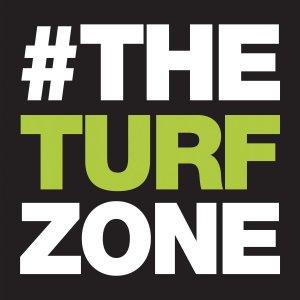The Turf Zone Podcast

Pennsylvania Turfgrass Council – Mid-Season Field Checkup
Pennsylvania Turfgrass – Tom Serensits and Andy McNitt
The heart of the fall sports season is now upon us. Although the stresses of summer heat have passed, the rigors of games and practices are not only hard on players and coaches, but the playing field too (Fig 1).
A few simple tips can help minimize the effects of field wear and tear whether you are managing natural or synthetic turf – or both.
Seed Early and Often
The importance of overseeding heavily-used fields and heavily-used areas within a field cannot be emphasized enough. Seeding is one of the most important in-season maintenance practices on heavily-used fields (Fig. 2).
You should not wait until the turf begins to thin. Seeding high-use areas before significant turf loss creates a “temporary seed bank” in the soil, which is ready to spring into action as the existing turf stand thins.
In almost all cases, perennial ryegrass provides the most in-season seeding success. Compared to other options such as Kentucky bluegrass and tall fescue, perennial ryegrass offers several advantages.
First is speed. Perennial ryegrass germinates in five to seven days and grows quickly after germinating. Germination and maturation time for both Kentucky bluegrass and tall fescue is much slower. Plus, perennial ryegrass will establish under slightly cooler temperatures compared to bluegrass or tall fescue.
Second, perennial ryegrass is less expensive (even though seed costs are up this year). You often will see blends of Kentucky bluegrass and perennial ryegrass, but for the best bang for your buck, stick with 100% perennial ryegrass. You don’t have time for Kentucky bluegrass to get established and it’s not very traffic tolerant when it’s young and immature. Plus it’s expensive in comparison to ryegrass. Previous research at Penn State shows that ryegrass is more traffic tolerant than tall fescue until both have been established for 14 weeks. That’s three and half months. You don’t have that kind of time, stick with ryegrass.
As for selecting the cultivar of perennial ryegrass to use, visit www.ntep.org and select the latest perennial ryegrass test date. The National Turfgrass Evaluation Program consists of turfgrass cultivar evaluations conducted at universities throughout the United States.
When looking at the perennial ryegrass data for several of the NTEP test sites closest to your location, don’t get hung up selecting the cultivar at the top of the list. Pick the cheapest cultivar in the top two-thirds of the list. Quality is important, but so is quantity, and if you can pick a good cultivar that is inexpensive, you can buy more seed. Also, the textbook suggestion of always mixing a minimum of three cultivars can be ignored in the case of highly trafficked turf.
First, the breeders tell us that there is already significant genetic variation within perennial ryegrass cultivars. Secondly, you are growing this grass almost like an annual. It gets worn out and replaced via additional seeding often. So the mantra is: cheap price for adequate quality and most importantly volume, volume, volume. Shoot for a minimum of 30 lbs per 1000 square feet per year. That seems like a lot, but we believe it should be set as your minimum for highly trafficked locations. Lower trafficked areas likely require much less (Fig 3.).
Timing – Dr. Dave Minner and Dr. Andrew Hoiberg (2013), authored several foundational research publications on this topic. Their conclusions were that seeding early in the season was more beneficial than seeding later. Upon reflection, this makes sense. Seed spread in mid-November doesn’t help the surface much during our fall season. Maybe it’s around to help next spring, but it’s not helping your field right now because it’s still in the bag. We’ve discussed this with Minner et al. over some adult beverages on more than one occasion.






 Visit Podcast Website
Visit Podcast Website RSS Podcast Feed
RSS Podcast Feed Subscribe
Subscribe
 Add to MyCast
Add to MyCast